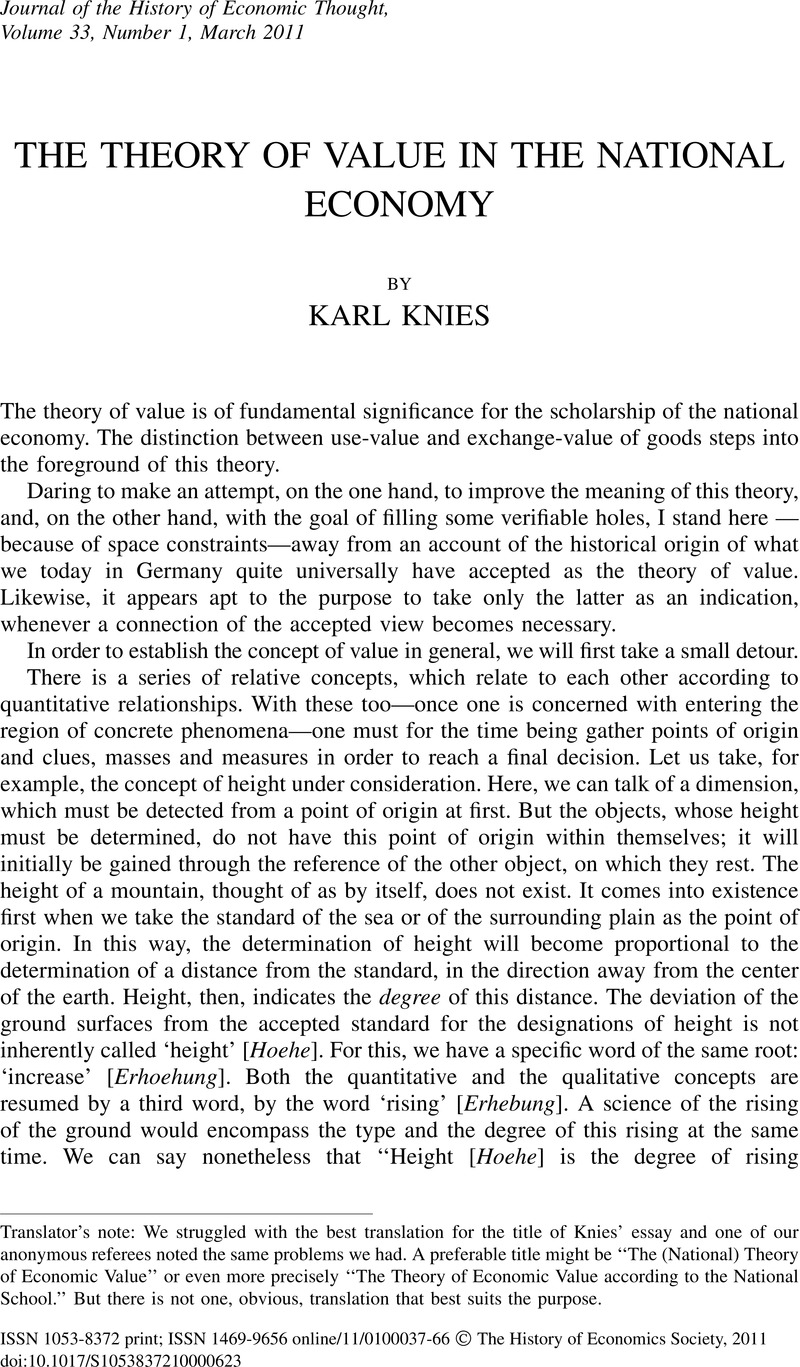Article contents
THE THEORY OF VALUE IN THE NATIONAL ECONOMY
Published online by Cambridge University Press: 01 April 2011
Abstract

- Type
- Research Articles
- Information
- Copyright
- Copyright © The History of Economics Society 2011
References
1 In the new edition I find the very enjoyable new sentence: “This abstract type-value (which has nothing to do with the own application through the owner himself) is primarily related to the abovementioned explanations in §.57 and 58.”
2 Rau, Textbook (Grundsätze der Volkswirthschaftlehre), §.61: “It is at this connection not precluded, that the sorts of different goods belonging to some kind of good also have unequal value.” Roscher, Principles, §.6: “The abstract or type-value is based on the relationship, which generally takes place between an entire kind of goods and the needs of men. And so does, for example, beech have a higher type-value than the pine as burning-material.” 6th Edition (1855): “The sorts of goods belonging to some kind of good have unequal type-value.”
3 (archaic) corn-measure (about 150 liters)
4 Absolutely different of course from the sentence, that the magnitude of the type-use-value and therefore of the type-exchange-value of goods is independent of the quantum of the type of goods, which becomes necessary for the satisfaction of the available needs, is the other sentence: that the need for use [Gebrauchsbeduerfnis] of a number of people can be directed only towards a smaller quantum, and that another one can be directed only or also towards a larger one. The number that desires the smaller quantum can be smaller than the larger one. But the desire of the greater number of people is always a cause, that we have a greater type-use-value and type-exchange-value of the concerned quantum to accept. Hence, the type-value of a smaller amount of credit of national debt is proportionally greater, as the one that is set on a greater amount, that of a small piece of stuff, of a cubit, than the rest smaller as that of one cubit to the entire piece.
5 National Economy of the present and the future, p. 318Google Scholar: The more the quantity of a useful object is aggrandized, the more falls the utility value of each individual piece, as the need remains unchanged. Then, as the utility value is always a relation of the things to man, so each type of goods has the mass of its utility value in the sum and rank-order of the human needs which it satisfies. The sum of the utility value that each type of good possesses remains unchangeable (as long as the human needs do not change), and it divides itself in the individual pieces of the type in equal quantities. The more the sum of the pieces becomes large, the less the share, which accrues to each piece from the utility-value of the type and vice versa. The smaller the mass becomes, the larger the share of each piece from the utility-value of the type. If one were to set the total need of a nation as 100, then the utility-value of each type of goods would be expressible in certain percentages. The utility-value of iron would be accepted as 5%, for example, under the assumption, that the national need does not change itself. At each moment, in which the production of iron rises, a new distribution of the 5% utility-value takes place on the individual quantities of the produced iron. While for the production of 500 centners, each centner of iron would possess 1/100 % of the total national utility-value, so for the production of 5000, 50000, 500000 centners, the utility-value of each centner would fall down to 0.001, 0.0001, 0.00001 % of the sum of all utility-value. Now, the total need of nations, however, never remains the same—each increase of the need effects the exchange-value just as much and in the same way as the utility-value.
6 Concrete value does not always coincide with the type-value, but it is together under the influence […] of the expansion of the need and of the goods already in possession of the person existing supply of other amounts of the good. The parts of the supply above the need are considered superfluous, because there is a lack of cause, to really make use of its usefulness. It can therefore now be used in trade as a means of exchange, and whoever—as one practices trade—does not take care of the resale will probably bring unto himself only so much of a sacrifice of each good, as he himself thinks of using. Therefore, often an object of the highest type-value is for many people without any or only with a very slight concrete value. Until the margin of the need, this type-value is the same.—Note c: The second specimen of the estimated book, of the copper table, is for the owner almost without any concrete value. Whoever has provided himself with the need, does not buy any more of the same object, if it is also still so inexpensive; he would then have to sell again or to want and to be able to save for longer.
7 During the printing of this essay, the author was in accord with the book about the explanation of value by Bastiat: “Main Features of the National Economy by Max Wirth”; it is yet reserved to enclose a hereby animated small addendum in the next booklets.
- 1
- Cited by




